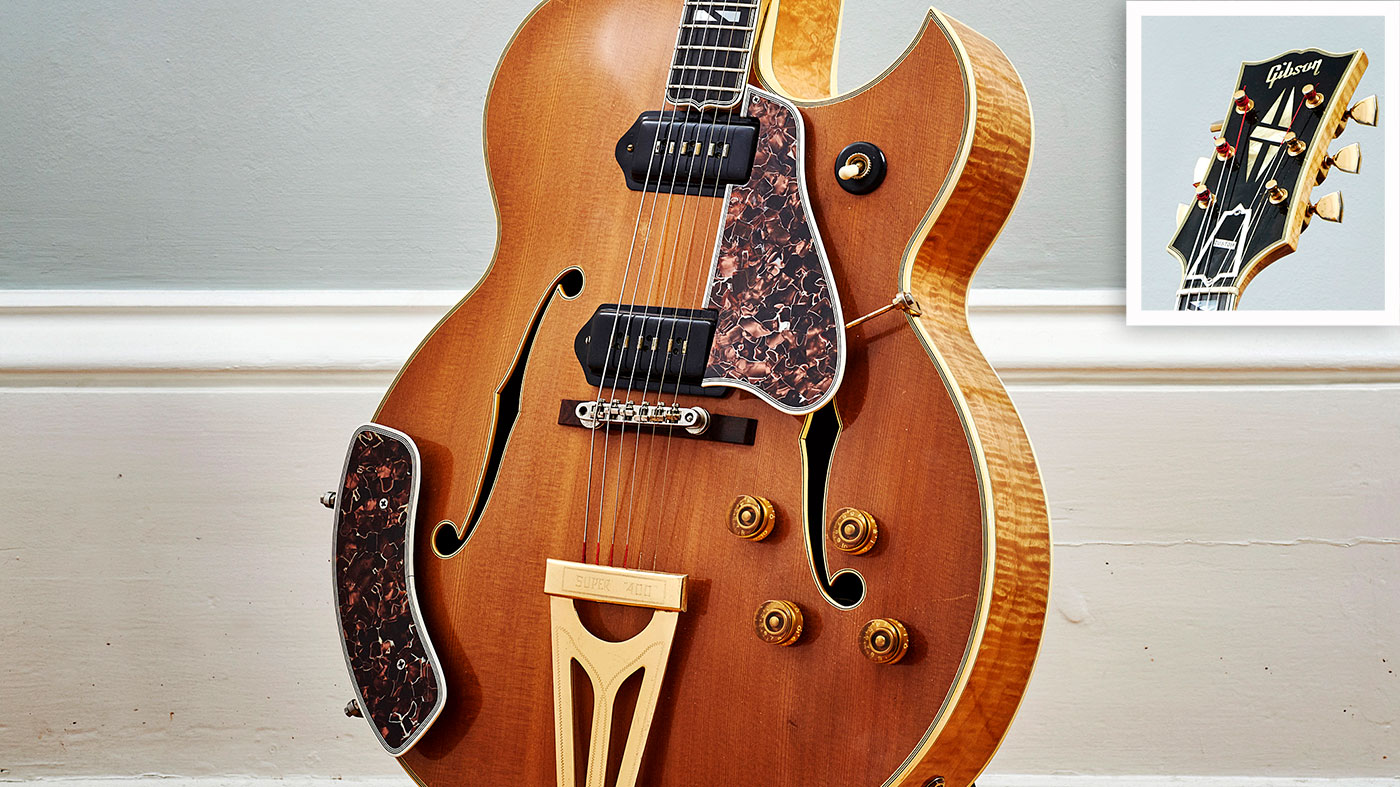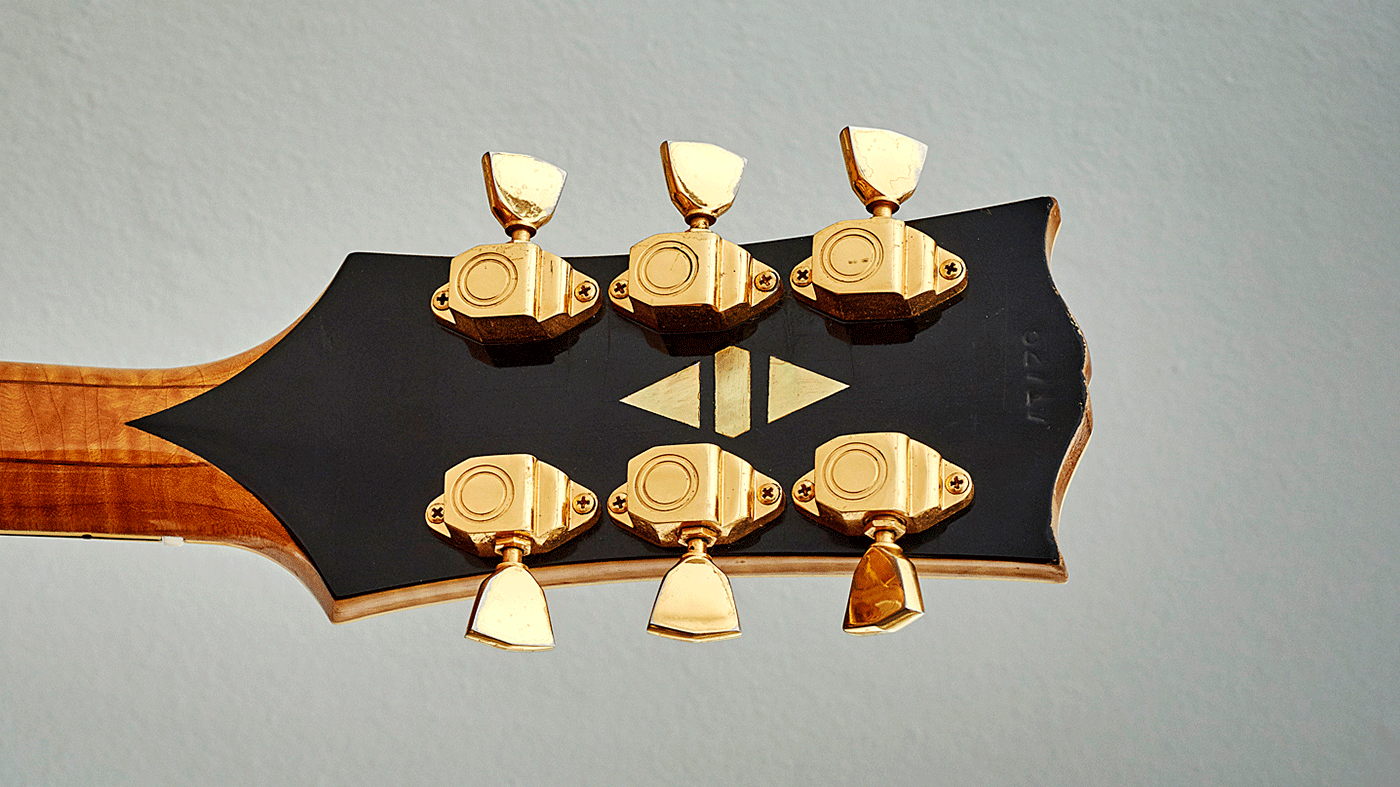
Distributed from 1951, the Super 400CES is the ‘Cutaway Electric Spanish’ version of Gibson’s highly ornate Super 400 carved spruce archtop guitar released earlier in 1935.
Measuring a full 18 inches in width, Super 400s remain to this day the largest of any Gibson guitar in regular production. They were marketed as the top-of-the-line instruments within their range, sporting gold-plated hardware with engraving, large mother-of-pearl inlays, multiple-ply binding, figured maple b ack, sides and neck, and an ebony fingerboard.
Super 400s are among the most finely crafted guitars ever built and are rightly regarded as works of art in themselves, with little expense being spared during their construction. Indeed, Gibson’s first official announcement of the Super 400 in 1934 proclaimed: “The Super 400 is an extraordinary guitar in everyway - its price is a criterion of its quality... Whether it takes two months or two years to build just one instrument, it must be perfect.”
The Super 400CES ultimately proved to be popular with a broad range of name guitarists, from jazz players to rock ’n’ rollers
The concept of the Super 400 emerged from a design and marketing overhaul of Gibson’s carved top/back archtops during the 1930s, which was intended to spread their price points across a greater number of potential customers. Subsequently, in 1935, Gibson ‘advanced’ the width of its seminal f-hole archtop, the L-5 (first released in 1922), from 16 to 17 inches, and applied the same enlargement to the L-10, L-12 and L-7 (originally released in 1929,1930 and 1932 respectively). Bigger was, apparently, better and with an unprecedented width of 18 inches, the new Super 400 was unveiled as Gibson’s crowning glory the same year, priced at $400.
It was a time of great innovation and Gibson soon began testing the waters with its new ‘Electric Spanish’ archtops alongside its latest acoustic archtop designs - firstly, with the ES-150, in 1936, shortly followed by the ES-100, ES-250 and ES-300 models (released in 1938,1939 and 1940 respectively). Gibson’s ES range proved to be a success, and although World War II put a temporary hold on electric guitar production, the company picked up the reins once again in 1947 and released the laminate-topped ES-125, ES-150 and ES-300, along with its cutaway-equipped sibling, the ES-350.
The following year, soon-to-be company president Ted McCarty arrived at Gibson, marking the beginning of a new ‘golden era’ under the watchful eye of the firm’s owners, Chicago Musical Instruments (or CMI). As the electric guitar became ever more popular, Ted explicitly sought to further expand Gibson’s range, beginning with the so-called ‘McCarty’-pickup- totingL-7E and L-7PE (Premiere/cutaway Electric), followed by the ES -175 and the distinctly upmarket ES-5 laminate topped instruments in 1949.
Keen to take on board suggestions from its more innovation-minded customers, Gibson began to develop dedicated electric versions of its foremost archtops, the Super 400 and L-5. Previously, if guitarists wanted to amplify these distinguished guitars, they would often turn to an aftermarket pickup assembly, but with the release of the Super 400CES and L-5CES in 1951, Gibson had finally succeeded in embracingthe advantages of the electric guitar in its most refined archtop designs.
Get the MusicRadar Newsletter
Want all the hottest music and gear news, reviews, deals, features and more, direct to your inbox? Sign up here.
Designed to reduce feedback with a slightly thicker carved top and more substantial bracing than its acoustic equivalent, the Super 400CES ultimately proved to be popular with a broad range of name guitarists, from jazz players to rock ’n’ rollers, and has remained in production ever since.
Custom-ordered 1963 Gibson Super 400CESN (Ex-Mark Knopfler)
1. The serial number
Impressed into back of headstock and inked onto orange label (visible through bassf-hole) “62717" with model designation “S 400 CESN"

2. Headstock
Black-painted holly veneer face; five-piece split diamond and Gibson logo mother-of-pearl inlays; three-piece split diamond mother-of-pearl inlay on black painted ‘bee sting'/ tapered rear
3. Body
18-inch wide carved spruce top; highly figured maple back/sides; pointed cutaway; natural finish (hence the name Super 400CESN) in clear lacquer

4. Pickups
Two Seth Lover-designed Alnico V single coils with independent volume and tone controls; three-way pickup selector switch
5. Hardware
Gold-plated brass Kluson Sealfast tuners, “SUPER 400" engraved tailpiece, strap button and jack socket; two-footed rosewood bridge base and Tune-o-matic bridge

6. Plastics
Binding: seven-ply top, three-ply back, five-ply fingerboard/headstock and three-ply f-hole; pointed black/white “CUSTOM" etched truss rod cover; black rubber switch grommet; plastic ‘marble’ pickguard and matching ‘banjo’ armrest; numbered gold speed knobs; white switch tip and heel cover
7. Neck
Three-piece highly figured maple neck with parallel mahogany separating strips; 20-fret pointed ebony 'board with single and double-split block mother-of-pearl inlays
The Evolution of the Gibson Super400CES
- 1935 Super 400 released; carved spruce top, carved 2-piece figured maple back
- 1951 Super 400CES released; rounded cutaway; 2x P-90 single coils
- 1954 2x Alnico V single coils now standard
- 1955 Tune-o-matic bridge introduced
- 1958 2x PAF humbucking pickups standard
- 1960 Rounded cutaway changes to pointed cutaway; wide/flat neck profile
- 1961 3-piece figured maple neck begins to replace 2-piece book-matched type
- 1962 Fuller neck profile; 1-piece laminated figured maple backs appear
- 1965 Nut width narrows to l/4inches
- 1969 Pointed cutaway reverts to rounded; nut width reverts to 1 % inches; 2-piece carved figured maple backs standard
Guitarist is the longest established UK guitar magazine, offering gear reviews, artist interviews, techniques lessons and loads more, in print, on tablet and on smartphones Digital: http://bit.ly/GuitaristiOS If you love guitars, you'll love Guitarist. Find us in print, on Newsstand for iPad, iPhone and other digital readers
“These guitars travel around the world and they need to be road ready”: Jackson gives Misha Mansoor’s Juggernaut a new lick of paint, an ebony fingerboard and upgrades to stainless steel frets in signature model refresh
“It’s about delivering the most in-demand mods straight from the factory”: Fender hot-rods itself as the Player II Modified Series rolls out the upgrades – and it got IDLES to demo them






![PRS Archon Classic and Mark Tremonti MT 15 v2: the newly redesigned tube amps offer a host of new features and tones, with the Alter Bridge guitarist's new lunchbox head [right] featuring the Overdrive channel from his MT 100 head, and there's a half-power switch, too.](https://cdn.mos.cms.futurecdn.net/FD37q5pRLCQDhCpT8y94Zi.jpg)





